HashMap原始碼深度剖析,手把手帶你分析每一行程式碼,包會!!!
HashMap原始碼深度剖析,手把手帶你分析每一行程式碼!
在前面的兩篇文章雜湊表的原理和200行程式碼帶你寫自己的HashMap(如果你閱讀這篇文章感覺有點困難,可以先閱讀這兩篇文章)當中我們仔細談到了雜湊表的原理並且自己動手使用線性探測法實現了我們自己的雜湊表MyHashMap。在本篇文章當中我們將仔細分析JDK當中HashMap的原始碼。
首先我們需要了解的是一個容器最重要的四個功能 增刪改查 ,而我們也是主要根據這四個功能進行展開一步一步的剖析HashMap的原始碼。在正式進行原始碼分析之前,先提一下:在JDK當中實現的HashMap解決雜湊衝突的辦法是使用鏈地址法,而我們自己之前在文章200行程式碼帶你寫自己的HashMap當中實現的MyHashMap解決雜湊衝突的辦法是線性探測法,大家注意一下這兩種方法的不同。
HashMap原始碼類中關鍵欄位分析
- 下面欄位表示預設的雜湊表的長度,也就是
HashMap底層使用陣列的預設長度,在HashMap當中底層所使用的的陣列的長度必須是2的整數次冪,這一點我們在文章200行程式碼帶你寫自己的HashMap已經仔細做出了說明。
/**
* The default initial capacity - MUST be a power of two.
*/
static final int DEFAULT_INITIAL_CAPACITY = 1 << 4; // aka 16
- 這個欄位表示雜湊表當中陣列的最大長度,
HashMap底層使用的陣列長度不能超過這個值。
/**
* The maximum capacity, used if a higher value is implicitly specified
* by either of the constructors with arguments.
* MUST be a power of two <= 1<<30.
*/
static final int MAXIMUM_CAPACITY = 1 << 30;
- 欄位
DEFAULT_LOAD_FACTOR的作用表示在HashMap當中預設的負載因子的值。
/**
* The load factor used when none specified in constructor.
*/
static final float DEFAULT_LOAD_FACTOR = 0.75f;
在實際情況當中我們並不是當HashMap當中的陣列完全被使用完之後才進行擴容,因為如果陣列快被使用完之後,再加入資料產生雜湊衝突的可能性就會很大,因此我們通常會設定一個負載因子(load factor),當陣列的使用率超過這個值的時候就進行擴容,即當(陣列長度為L,陣列當中資料個數為S,負載因子為F):
TREEIFY_THRESHOLD這個欄位主要表示將連結串列(在JDK當中是採用鏈地址法去解決雜湊衝突的問題)變成一個紅黑樹(如果你不瞭解紅黑樹,可以將其認為是一種平衡二元樹)的條件,在JDK1.8之後JDK中實現HashMap不僅採用鏈地址法去解決雜湊衝突,而且連結串列滿足一定條件之後會將連結串列變成一顆紅黑樹。而將連結串列變成一顆紅黑樹的必要條件是連結串列當中資料的個數要大於等於TREEIFY_THRESHOLD,請大家注意是必要條件不是充分條件,也就是說滿足這個條件還不行,它還需要滿足另外一個條件,就是雜湊表中陣列的長度要大於等於MIN_TREEIFY_CAPACITY,MIN_TREEIFY_CAPACITY在JDK當中的預設值是64。
/**
* The bin count threshold for using a tree rather than list for a
* bin. Bins are converted to trees when adding an element to a
* bin with at least this many nodes. The value must be greater
* than 2 and should be at least 8 to mesh with assumptions in
* tree removal about conversion back to plain bins upon
* shrinkage.
*/
static final int TREEIFY_THRESHOLD = 8;
/**
* The smallest table capacity for which bins may be treeified.
* (Otherwise the table is resized if too many nodes in a bin.)
* Should be at least 4 * TREEIFY_THRESHOLD to avoid conflicts
* between resizing and treeification thresholds.
*/
static final int MIN_TREEIFY_CAPACITY = 64;
UNTREEIFY_THRESHOLD表示當在進行resize操作的過程當中,紅黑樹當中的節點個數小於UNTREEIFY_THRESHOLD時,就需要將一顆紅黑樹重新恢復成連結串列。
/**
* The bin count threshold for untreeifying a (split) bin during a
* resize operation. Should be less than TREEIFY_THRESHOLD, and at
* most 6 to mesh with shrinkage detection under removal.
*/
static final int UNTREEIFY_THRESHOLD = 6;
- 下列程式碼當中的
table陣列物件就是HashMap底層當中真正用於儲存資料的陣列。
/**
* The table, initialized on first use, and resized as
* necessary. When allocated, length is always a power of two.
* (We also tolerate length zero in some operations to allow
* bootstrapping mechanics that are currently not needed.)
*/
transient Node<K,V>[] table;
size表示雜湊表中儲存的key-value物件的個數,也就是放入了多少個鍵值物件。
/**
* The number of key-value mappings contained in this map.
*/
transient int size;
threshold表示容器當中能夠儲存的資料個數的閾值,當HashMap當中儲存的資料的個數超過這個值的時候,HashMap底層使用的陣列就需要進行擴容。下列公式中Capacity表示底層陣列的長度(2的整數次冪,注意與size進行區分)。
int threshold;
/**
* The load factor for the hash table.
*
* @serial
*/
final float loadFactor;
HashMap底層陣列當中的節點類
在上篇雜湊表的設計原理當中我們已經仔細說明,在HashMap當中我們是使用陣列去儲存具體的資料的,那麼在我們的陣列當中應該儲存什麼樣的資料呢?假設在HashMap的陣列當中儲存的資料型別為Node,那麼這個類需要有哪些欄位呢?
-
首先一點我們肯定需要儲存
Value值,因為我們最終需要通過get方法從HashMap當中取出我們所需要的值。 -
第二點當我們通過
get方法去取值的時候是通過Key(鍵值)去取的,當雜湊值產生衝突的時候,我們不僅需要通過雜湊值確定位置,還需要通過比較通過函數get傳遞的Key和陣列當當中儲存的資料的key是否相等,因此我們需要儲存鍵值Key。 -
第三點為了避免重複計算雜湊值(因為有的物件的雜湊值計算還是比較費時間),我們可以使用一個欄位去儲存計算好的雜湊值。
基於以上三點,在JDK當中的HashMap內部的節點類主要結構如下。
static class Node<K,V> implements Map.Entry<K,V> {
final int hash;
final K key;
V value;
Node<K,V> next;
Node(int hash, K key, V value, Node<K,V> next) {
this.hash = hash;
this.key = key;
this.value = value;
this.next = next;
}
public final K getKey() { return key; }
public final V getValue() { return value; }
public final String toString() { return key + "=" + value; }
public final int hashCode() {
return Objects.hashCode(key) ^ Objects.hashCode(value);
}
public final V setValue(V newValue) {
V oldValue = value;
value = newValue;
return oldValue;
}
public final boolean equals(Object o) {
if (o == this)
return true;
if (o instanceof Map.Entry) {
Map.Entry<?,?> e = (Map.Entry<?,?>)o;
if (Objects.equals(key, e.getKey()) &&
Objects.equals(value, e.getValue()))
return true;
}
return false;
}
}
我們用下面兩行程式碼說明上面類的結構:
HashMap<String, Integer> map = new HashMap<>();
map.put("一無是處的研究僧", 888);
在上面的程式碼當中put函數的引數"一無是處的研究僧"就是上面Node類當中的key,888就是Node類當中的value物件,上面的類當中的hash物件就是字串"一無是處的研究僧"的雜湊值,但是事實上他還需要經過一段程式碼的處理:
/**
* 這個 key 是 put 函數傳進來的 key
* @param key
* @return
*/
static int hash(Object key) {
int h;
// 呼叫物件自己實現的 hashCode 方法
// key.hashCode() = "一無是處的研究僧".hashCode
return (key == null) ? 0 : (h = key.hashCode()) ^ (h >>> 16);
}
上面的函數之所以要將物件的雜湊值右移16,是因為我們的陣列的長度一般不會超過\(2^{16}\),因為\(2^{16}\)已經是一個比較大的值了,因此當雜湊值與\(2^n - 1\)進行&操作的時候,高位通常沒有使用到,這樣做的原理是可以充分利用資料雜湊值當中的資訊。
tableSizeFor函深入剖析
/**
* Returns a power of two size for the given target capacity.
*/
/**
* 返回第一個大於或者等於 capacity 且為 2 的整數次冪的那個數
* @param capacity
* @return
*/
static final int tableSizeFor(int cap) {
int n = cap - 1;
n |= n >>> 1;
n |= n >>> 2;
n |= n >>> 4;
n |= n >>> 8;
n |= n >>> 16;
// 如果最終得到的資料小於 0 則初始長度為 1
// 如果長度大於我們所允許的最大的容量 則將初始長度設定為我們
// 所允許的最大的容量
// MAXIMUM_CAPACITY = 1 << 30;
return (n < 0) ? 1 : (n >= MAXIMUM_CAPACITY) ? MAXIMUM_CAPACITY : n + 1;
}
因為我們需要底層使用的陣列table的長度是2的整數次冪,而我們之後在初始化函數當中會允許使用者輸入一個陣列長度的大小,但是使用者輸入的數位可能不是2的整數次冪,因此我們需要將使用者輸入的資料變成2的整數次冪,我們可以將使用者輸入的資料變成大於等於這個數的最小的2的整數次冪。
比如說如果使用者輸入的是12我們需要將其變成16,如果輸入的是28我們需要將其變成32。我們可以通過上面的函數做到這一點。
上面的程式碼還是很難理解的,讓我們一點一點的來分析。首先我們使用一個2的整數次冪的數進行上面移位元運算的操作!
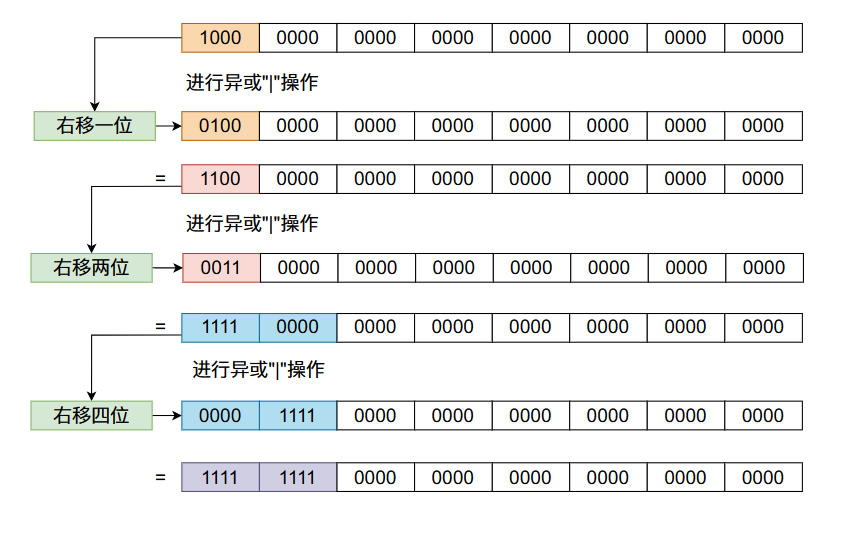
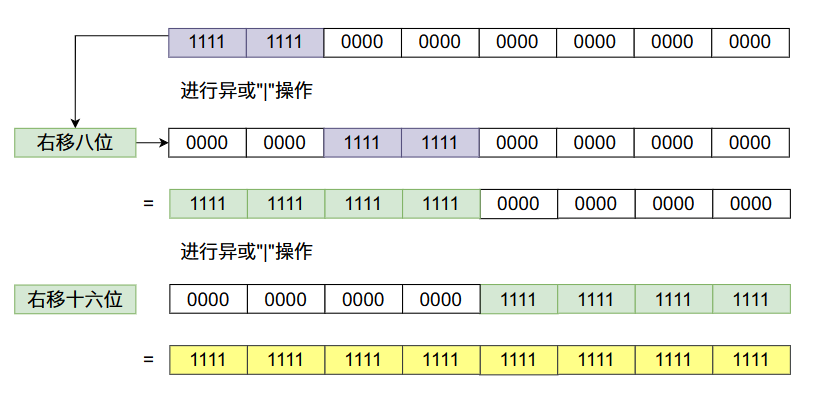
從上圖當中我們會發現,我們咋一個數的二進位制數的32位元放一個1,經過移位之後最終32位的位元數位全部變成了1。根據上面數位變化的規律我們可以發現,任何一個位元經過上面移位的變化,這個位元后面的31個位元位都會變成1,像下圖那樣:

因此上述的移位元運算的結果只取決於最高一位的位元值為1,移位元運算後它後面的所有位元位的值全為1,而在上面函數的最後,如果最終的容量沒有大於我們設定的最大容量MAXIMUM_CAPACITY,我們返回的結果就是上面移位之後的結果 +1。又因為移位之後最高位的1到最低位的1之間的位元值全為1,當我們+1之後他會不斷的進位,最終只有一個位元位置是1,因此它是2的整數倍。

在tableSizeFor函數當中,給初始容量減了個1,這樣做的原因是讓這個函數的返回值大於等於傳入的引數capacity:
tableSizeFor(4) == 4 // 就是當傳入的資料已經是 2 的整數次冪的時候也返回傳入的值
tableSizeFor(3) == 4
tableSizeFor(5) == 8
HashMap建構函式分析
首先我們先看一下幾個建構函式的程式碼:
public HashMap(int initialCapacity) {
// 指定初始容量的建構函式
this(initialCapacity, DEFAULT_LOAD_FACTOR);
}
public HashMap() {
this.loadFactor = DEFAULT_LOAD_FACTOR; // all other fields defaulted
}
public HashMap(int initialCapacity, float loadFactor) {
if (initialCapacity < 0)
throw new IllegalArgumentException("Illegal initial capacity: " +
initialCapacity);
// 如果大於允許的最大容量,就將陣列的長度這是為最大容量
if (initialCapacity > MAXIMUM_CAPACITY)
initialCapacity = MAXIMUM_CAPACITY;
if (loadFactor <= 0 || Float.isNaN(loadFactor))
throw new IllegalArgumentException("Illegal load factor: " +
loadFactor);
this.loadFactor = loadFactor;
// 這裡本來應該將 threshold 的值設定為陣列長度的 * load factor,
// 但是在 HashMap 的原始碼當中
// 並沒有一個變數儲存陣列的長度,因為陣列的長度直接 array.length
// 就可以得到,因此也沒必要,而在 HashMap 當中,使用懶載入
// 只有在使用 put 函數的時候才申請陣列 因此需要一個變數儲存陣列的長度
// 而此時 threshold 並沒有使用,因此可以臨時用於儲存 陣列的長度
// 在後面申請陣列是,將 threshold 更新為 陣列長度 * load factor
this.threshold = tableSizeFor(initialCapacity);
}
HashMap的建構函式整體來說比較簡單,但是上面程式碼當中最後一行很容易讓人迷惑,具體原因在上面的註釋當中已經說明了,大家可以閱讀一下。
HashMap的增刪改查函數分析
put函數分析——「增改」
public V put(K key, V value) {
return putVal(hash(key), key, value, false, true);
}
static final int hash(Object key) {
int h;
return (key == null) ? 0 : (h = key.hashCode()) ^ (h >>> 16);
}
在put函數當中首先計算引數key的雜湊值,然後呼叫putVal函數真正的將輸入插入到資料當中,為了方便大家於都程式碼,程式碼解釋在程式碼當中對應的位置。
在正式閱讀這個程式碼之前我們先分析這個函數的流程:
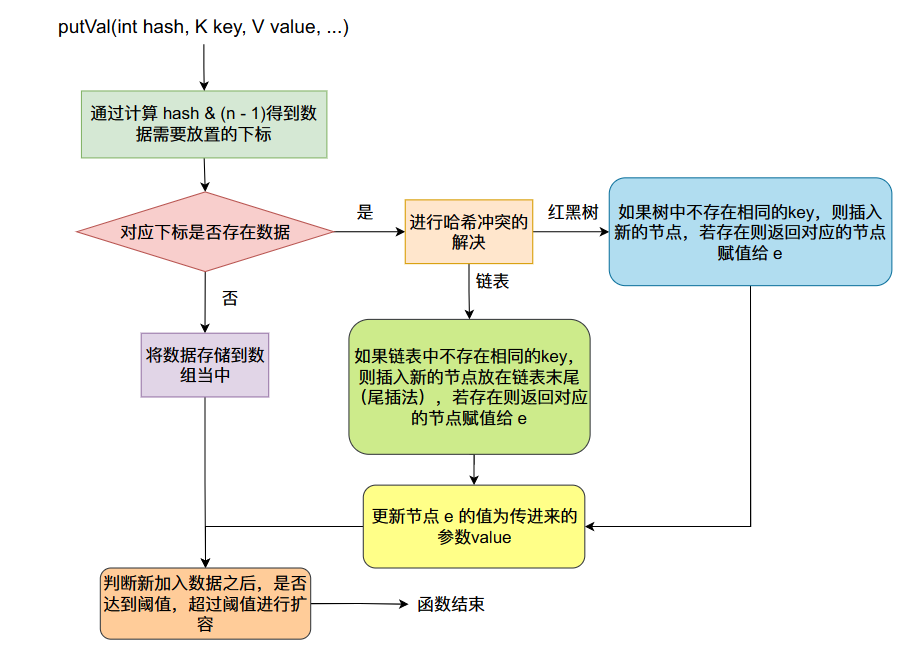
final V putVal(int hash, K key, V value, boolean onlyIfAbsent,
boolean evict) {
// 我們先只管前面三個引數,後的引數可以先不管
Node<K,V>[] tab; Node<K,V> p; int n, i;
// 這裡是首次呼叫函數 putVal 的時候這個 if 條件會通過
// 因為第一次呼叫這個函數的時候還沒有申請陣列 所以 table == null
if ((tab = table) == null || (n = tab.length) == 0)
// 進行擴容
n = (tab = resize()).length;
// 如果計算出的下標對應資料還沒有村資料直接將資料加入到陣列
// 當中即可
// 這行程式碼不僅會將tab[i = (n - 1) & hash] 的結果賦值給 p
// (p = tab[i = (n - 1) & hash]) 這行程式碼的返回值也是 tab[i = (n - 1) & hash]
if ((p = tab[i = (n - 1) & hash]) == null)
tab[i] = newNode(hash, key, value, null);
else {
// 如果對應位置當中已經存在資料了
// 即產生了雜湊衝突,要採用鏈地址法進行解決
Node<K,V> e; K k;
// 如果傳入的雜湊值和對應下標的資料的雜湊值相等
// 而且兩個 key 相等,這個 if 語句的條件就滿足了
// 然後將對應下標的資料賦值給 e 然後在後續的程式碼當中
// 更新 e 當中的 value 為 putVal 函數傳入的 value
// 即 e.value = value;
if (p.hash == hash &&
((k = p.key) == key || (key != null && key.equals(k))))
e = p;
else if (p instanceof TreeNode)
// 如果 p 是一個紅黑樹節點,就在紅黑樹當中放入資料
// 在本篇文章當中我們不仔細去討論這個函數,因為紅黑樹
// 的操作比較複雜,我們之後再專門寫一篇關於紅黑樹的文章來講解這個問題
e = ((TreeNode<K,V>)p).putTreeVal(this, tab, hash, key, value);
else {
// 這裡就是連結串列的操作了
for (int binCount = 0; ; ++binCount) {
// 如果 e.next == null 說明已經遍歷到最後一個節點了
// 需要將新加入的
if ((e = p.next) == null) {
p.next = newNode(hash, key, value, null);
// 如果節點數超過 TREEIFY_THRESHOLD 就需要進行後續的操作
// 在 treeifyBin 函數當中會有一個判斷,如果陣列的長度大於
// MIN_TREEIFY_CAPACITY 就將連結串列變成紅黑樹,否則直接進行擴容
if (binCount >= TREEIFY_THRESHOLD - 1) // -1 for 1st
treeifyBin(tab, hash);
break;
}
// 如果找到相同的 key 就跳出去
if (e.hash == hash &&
((k = e.key) == key || (key != null && key.equals(k))))
break;
p = e;
}
}
// 當存在一個物件的 key 和傳進這個函數的 key 相同的話
// 就需要進行 value 的更新,相當於將新的 value 替換掉舊的
// value
if (e != null) { // existing mapping for key
V oldValue = e.value;
if (!onlyIfAbsent || oldValue == null)
e.value = value;
afterNodeAccess(e);
return oldValue;
}
}
++modCount;
// 如果容器當中資料的數量大於閾值的話就進行擴容
if (++size > threshold)
resize();
afterNodeInsertion(evict); // 這個函數在 HashMap 沒啥用,他的函數體為空
return null;
}
resize擴容函數分析
final Node<K,V>[] resize() {
Node<K,V>[] oldTab = table;
// 舊陣列的陣列長度
int oldCap = (oldTab == null) ? 0 : oldTab.length;
// 舊的擴容的閾值
int oldThr = threshold;
int newCap, newThr = 0;
if (oldCap > 0) {
if (oldCap >= MAXIMUM_CAPACITY) {
threshold = Integer.MAX_VALUE;
return oldTab;
}
else if ((newCap = oldCap << 1) < MAXIMUM_CAPACITY &&
oldCap >= DEFAULT_INITIAL_CAPACITY)
newThr = oldThr << 1; // double threshold
}
else if (oldThr > 0) // initial capacity was placed in threshold
newCap = oldThr;
else { // zero initial threshold signifies using defaults
newCap = DEFAULT_INITIAL_CAPACITY;
newThr = (int)(DEFAULT_LOAD_FACTOR * DEFAULT_INITIAL_CAPACITY);
}
if (newThr == 0) {
float ft = (float)newCap * loadFactor;
newThr = (newCap < MAXIMUM_CAPACITY && ft < (float)MAXIMUM_CAPACITY ?
(int)ft : Integer.MAX_VALUE);
}
// 上面的程式碼主要是計算得到新的閾值 newThr 和陣列長度 newCap
threshold = newThr;
@SuppressWarnings({"rawtypes","unchecked"})
// 開闢新的陣列空間
Node<K,V>[] newTab = (Node<K,V>[])new Node[newCap];
table = newTab;
// 現在需要將舊陣列當中的資料加入到新陣列
if (oldTab != null) {
for (int j = 0; j < oldCap; ++j) {
Node<K,V> e;
if ((e = oldTab[j]) != null) {
oldTab[j] = null;
// e.next == null 表示只有一個資料,並沒有形成 2 個
// 資料以上的連結串列,因此可以直接加入到心得陣列 當中
if (e.next == null)
newTab[e.hash & (newCap - 1)] = e;
else if (e instanceof TreeNode)
// 如果節點是紅黑樹節點,則在將紅黑樹當中的節點加入到新陣列當中
((TreeNode<K,V>)e).split(this, newTab, j, oldCap);
else { // preserve order
// 連結串列的程式碼比較複雜,大家可以看下面的分析
Node<K,V> loHead = null, loTail = null;
Node<K,V> hiHead = null, hiTail = null;
Node<K,V> next;
do {
next = e.next;
if ((e.hash & oldCap) == 0) {
if (loTail == null)
loHead = e;
else
loTail.next = e;
loTail = e;
}
else {
if (hiTail == null)
hiHead = e;
else
hiTail.next = e;
hiTail = e;
}
} while ((e = next) != null);
if (loTail != null) {
loTail.next = null;
newTab[j] = loHead;
}
if (hiTail != null) {
hiTail.next = null;
newTab[j + oldCap] = hiHead;
}
}
}
}
}
return newTab;
}
擴容時連結串列資料的下標分析
為了解釋上面的連結串列的從舊陣列移動到新陣列的過程,我們先通過下面的例子來分析一下:
現在有一個雜湊表在工作時候的情況,在進行擴容之前他的結構如下圖所示:
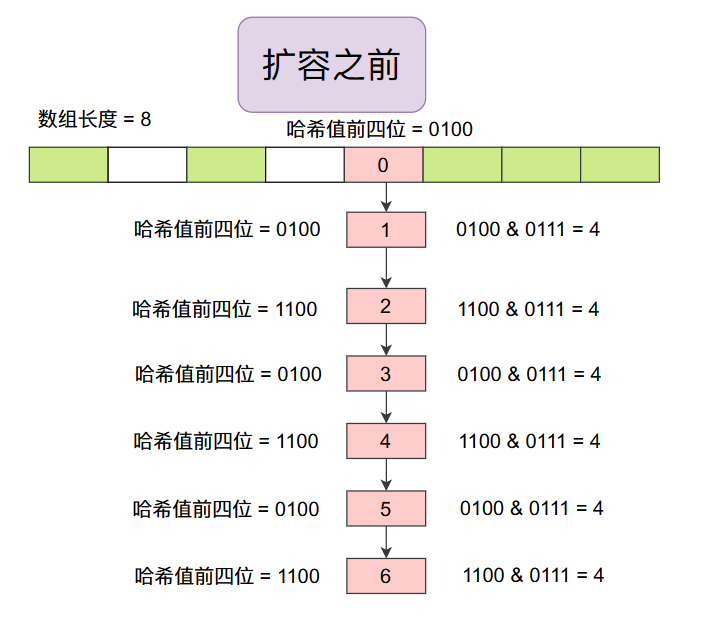
在擴容之前陣列的長度等於8,那麼乘以2倍擴容之後,陣列的長度應該變成16,而且連結串列當中的資料需要進行重新&的操作,再將其放在新的陣列當中,擴容重新進行&操作之後陣列的情況如下圖所示:
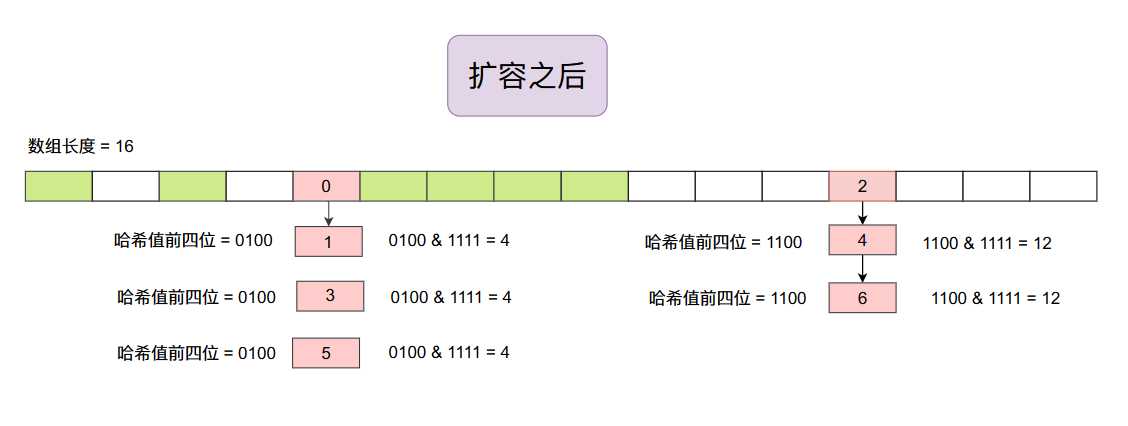
從上面的兩張圖我們可以發現,與元素的雜湊值進行&運算的陣列長度減1的二進位制數表示會多出一個1,即:
如果資料的雜湊值對應的位置也是1比如上圖當中資料2、4、6的情況,那麼我們在確定資料在新陣列當中的位置的時候不需要重新進行&運算,只需要在舊陣列的位置加上原陣列的長度就是資料在新陣列當中的位置。為什麼?
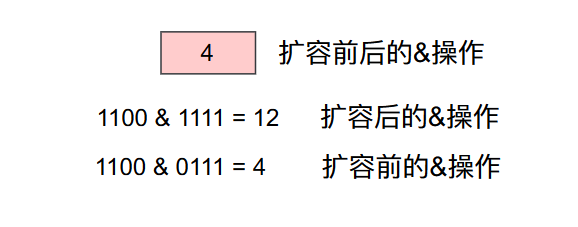
從上圖我們可以發現擴容前後與key的雜湊值進行&操作的資料的二進位制數只是在高位增加了一個1,因此我們直接將原陣列的下標加上這個高位1對應的10進位制數(這個十進位制數對應就是原陣列的長度)就得到的資料在新陣列的下標。而如果雜湊值的二進位制表示當中相應的高位的位元值為0,那麼擴容前後他在陣列當中的位置是沒有發生變化的。
而能進行上面談到的操作的資料需要滿足一個特點就是資料的雜湊值對應的高位也是1,才能進行這個操作。這也是下面程式碼的if判斷的內容:
// 和陣列的長度進行&操作看看高位是不是0
if ((e.hash & oldCap) == 0) {
// 如果對應的高位為0
if (loTail == null)
loHead = e;
else
loTail.next = e;
loTail = e;
}
else {
// 如果對應的高位為 1
if (hiTail == null)
hiHead = e;
else
hiTail.next = e;
hiTail = e;
}
連結串列擴容程式碼變數分析
上面的程式碼涉及四個節點loTail和loHead,hiTail和hiHead的相關操作,首先我們先弄清楚這四個變數的含義是什麼。
從上面擴容前後連結串列當中的資料下標分析我們可以知道,一個連結串列在擴容之後會放在新陣列的兩個位置,如果連結串列資料在舊陣列下標為x的位置,舊陣列的長度為L,那麼擴容之後資料在新陣列的位置分別為x和x + L的位置,整個的擴容過程和loTail和loHead,hiTail和hiHead的指向如下圖所示:
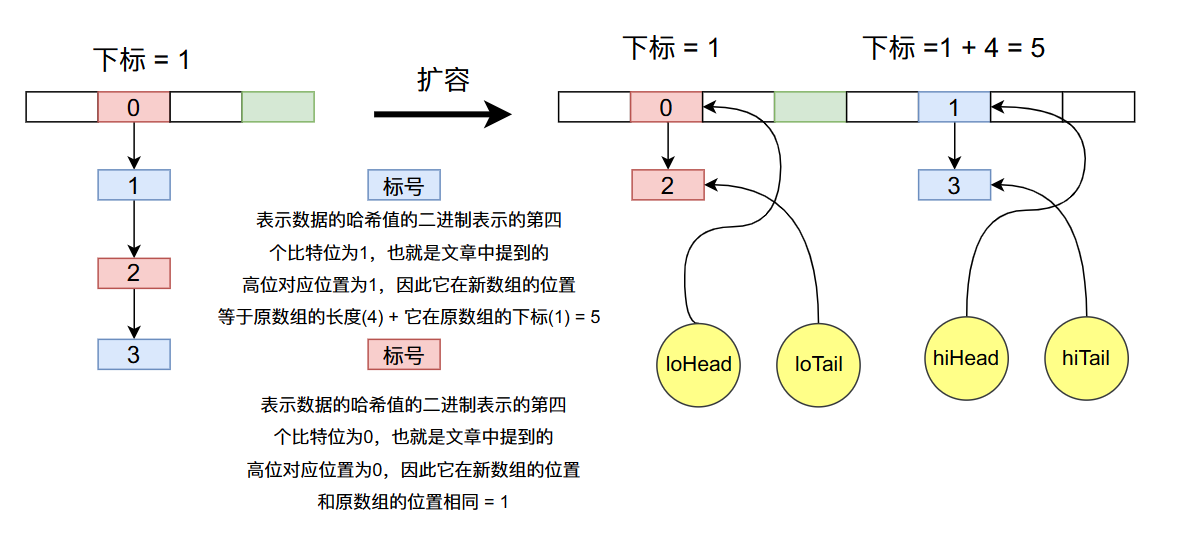
loTail和loHead新陣列當中下標為x的連結串列的表尾和表頭,hiTail和hiHead表示下標為x + L的連結串列的表尾和表頭。
看到現在相信你已經能看懂下面的程式碼了:
Node<K,V> loHead = null, loTail = null;
Node<K,V> hiHead = null, hiTail = null;
Node<K,V> next;
do {
next = e.next;
if ((e.hash & oldCap) == 0) {
if (loTail == null)
loHead = e;
else
loTail.next = e;
loTail = e;
}
else {
if (hiTail == null)
hiHead = e;
else
hiTail.next = e;
hiTail = e;
}
} while ((e = next) != null);
if (loTail != null) {
loTail.next = null;
newTab[j] = loHead;
}
if (hiTail != null) {
hiTail.next = null;
newTab[j + oldCap] = hiHead;
}
get函數分析——「查」
如果你已經看懂了put和resize函數,這個函數就很簡單了。
- 首先計算資料在陣列當中的下標值
(n - 1) & hash。 - 如果下標中第一個節點的
key就等於引數傳入的key,就直接返回資料。 - 如果節點是紅黑樹當中的節點就通過紅黑樹進行查詢,否則就是連結串列節點,然後通過連結串列的方式查詢。
- 找到相同的
key資料,將結果返回。
public V get(Object key) {
Node<K,V> e;
return (e = getNode(hash(key), key)) == null ? null : e.value;
}
final Node<K,V> getNode(int hash, Object key) {
Node<K,V>[] tab; Node<K,V> first, e; int n; K k;
if ((tab = table) != null && (n = tab.length) > 0 &&
(first = tab[(n - 1) & hash]) != null) {
if (first.hash == hash && // always check first node
((k = first.key) == key || (key != null && key.equals(k))))
return first;
if ((e = first.next) != null) {
if (first instanceof TreeNode)
return ((TreeNode<K,V>)first).getTreeNode(hash, key);
do {
if (e.hash == hash &&
((k = e.key) == key || (key != null && key.equals(k))))
return e;
} while ((e = e.next) != null);
}
}
return null;
}
remove函數分析——「刪」
整個函數分成一下兩個步驟:
- 先找到要刪除的節點。
- 刪除找到的節點。
大家在理解上面「增改查」三個操作之後,下面的程式碼很容易理解了,下面程式碼有註釋幫助大家理解。
public V remove(Object key) {
Node<K,V> e;
return (e = removeNode(hash(key), key, null, false, true)) == null ?
null : e.value;
}
final Node<K,V> removeNode(int hash, Object key, Object value,
boolean matchValue, boolean movable) {
// matchValue 這個引數如果為 true 表示傳入的引數 value
// 和查詢到的資料的 value 相等才進行刪除
Node<K,V>[] tab; Node<K,V> p; int n, index;
// 先找到節點
if ((tab = table) != null && (n = tab.length) > 0 &&
(p = tab[index = (n - 1) & hash]) != null) {
Node<K,V> node = null, e; K k; V v;
if (p.hash == hash &&
((k = p.key) == key || (key != null && key.equals(k))))
node = p;
else if ((e = p.next) != null) {
if (p instanceof TreeNode)
node = ((TreeNode<K,V>)p).getTreeNode(hash, key);
else {
do {
if (e.hash == hash &&
((k = e.key) == key ||
(key != null && key.equals(k)))) {
node = e;
break;
}
p = e;
} while ((e = e.next) != null);
}
}
// 刪除節點
if (node != null && (!matchValue || (v = node.value) == value ||
(value != null && value.equals(v)))) {
if (node instanceof TreeNode)
((TreeNode<K,V>)node).removeTreeNode(this, tab, movable);
else if (node == p)
tab[index] = node.next;
else
p.next = node.next;
++modCount;
--size;
afterNodeRemoval(node);
return node;
}
}
return null;
}
總結
本篇文章主要跟大家一起分析了HashMap當中主要的原始碼,主要涉及四個操作增刪改查,但是沒有仔細分析關係紅黑樹的部分,因為紅黑樹涉及的部分比較多,本篇文章已經比較長了,以後專門寫一篇文章仔細分析紅黑樹的部分。
在HashMap當中有很多寫的很巧妙的程式碼,比如說tableSizeFor函數,擴容的時候兩條連結串列的操作,這些設計都非常巧妙,希望大家有所收穫。我是LeHung,我們下期再見!!!
更多精彩內容合集可存取:https://github.com/Chang-LeHung/CSCore。
關注微信公眾號:一無是處的研究僧,瞭解更多計算機知識~~~~